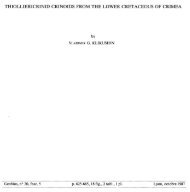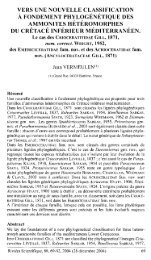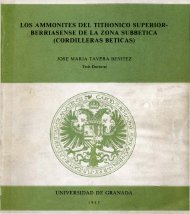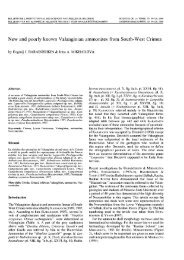peter franklin rawson, dennis curry, frank charles dilley, john michael ...
peter franklin rawson, dennis curry, frank charles dilley, john michael ...
peter franklin rawson, dennis curry, frank charles dilley, john michael ...
Create successful ePaper yourself
Turn your PDF publications into a flip-book with our unique Google optimized e-Paper software.
(Meuse) in France, and Folkestone, Kent, in England. Following Breistroffer (1947),the Albian is regarded as commencing with the Leymeriella tardefurcata Zone.Renevier (1867) introduced the term ‘Vraconian’ for a horizon thought to beequivalent to the English Upper Gault and Upper Greensand and to be intermediatebetween the typical Albian and the Cenomanian. Although some authors haveallowed it to survive as a substage term (e.g. Drummond 1970), it is merely anothername for the Stoliczkaia dispar Zone and is therefore superfluous. Jukes-Browne’sterm Selbornian {in Jukes-Browne & Hill 1900), proposed expressly for the EnglishGault and Upper Greensand, has not been adopted.In mainland Britain, strata of Albian age are divided into the following substagesand zones:Middle AlbianStoliczkaia disparMortoniceras inflatumEuhoplites lautusEuhoplites loricatusHoplites dentatusDouvilleiceras mammillatumLeymeriella tardefurcataThe tardefurcata Zone was conceived by Jacob (1907) for the whole of the LowerAlbian as now understood and was originally based on occurrences in south-eastFrance, the Paris Basin and Switzerland. Recognition of this zone in the LowerGreensand derives from the work of Spath and Casey. A subzonal sequence based onsuccessive faunas of Proleymeriella and Leymeriella has been established in theHanover region of north Germany (Brinkmann 1937). In England the hoplitidFamhamia replaces Proleymeriella at the base of the zone (Casey 1961a) and thereis a widespread break in sedimentation below the horizon of Leymeriella regularis—the ‘mid-tardefurcata break’ of Casey (1961a).A zone of ‘Ammonites mammillaris’ (recte mammillatus) was taken by de Ranee(1868) to mark the top of the ‘Aptian or Lower Greensand’ of Folkestone.Subsequently Barrois (1874) applied the term to the lowest zone of the Albian of theParis Basin. The current concept of the mammillatum Zone stems from Casey(1961a), who has shown its several subzones to have a wide distribution in southernEngland. Destombes (1973), working in northern France, drops the term mammillatumZone in favour of a Zone of Sonneratia dutempleana below and a Zone ofOtohoplites raulinianus above but the zonal indices occur in reverse order in theEnglish sequence.Though originally applied by Jacob (1907) only to the pyritic Middle Albian ofSainte-Croix and the Paris Basin, the term ‘dentatus Zone’ has proved to be a usefulreplacement name for the old ‘Ammonites interruptus’ Zone, invalidated by nomenclatorialirregularity. It is ubiquitous at the base of the European Middle Albian andis capable of subzonal division is south-east England (Spath 1941; Casey 1961a;Owen 1971).
















